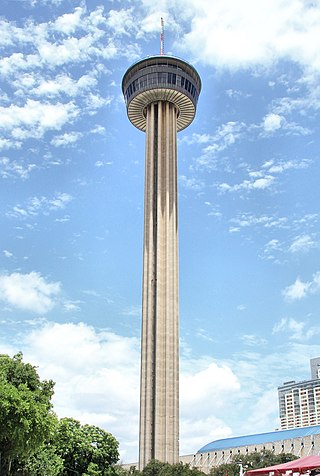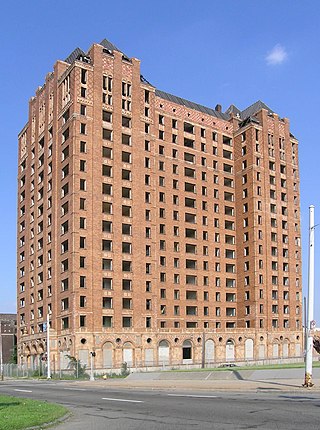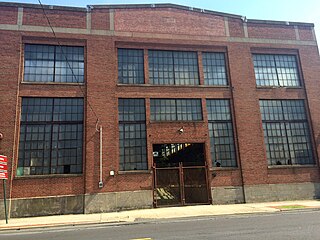
Bowie County is a county in the U.S. state of Texas. Its legal county seat is Boston, though its courthouse is located in New Boston. As of the 2020 census, the population was 92,893. Bowie County is part of the Texarkana metropolitan statistical area. The county is named for James Bowie, the legendary knife fighter who died at the Battle of the Alamo.
Boston is an unincorporated community in, and the county seat of, Bowie County, Texas, United States. According to the Handbook of Texas, the community had a population of 200 in 2000. It is part of the Texarkana metropolitan area.

HemisFair '68 was the official 1968 World's Fair held in San Antonio, Texas, from April 6 through October 6, 1968. Local businessman and civic leader, Jerome K. Harris Sr., coined the name HemisFair and conceived the idea for the fair, hoping it would unite all the cultures that comprise San Antonio and solidify the city's reputation as a cultural and historic destination. With help from commissioner Henry B. Gonzales and other San Antonio leaders, the fair materialized and helped transform the city from a cowtown to one of the largest cities in the country. The theme of the fair was "The Confluence of Civilizations in the Americas", celebrating the many nations which settled the region. The fair was held in 1968 to coincide with the 250th anniversary of the founding of San Antonio in 1718. More than thirty nations and fifteen corporations hosted pavilions at the fair.

Redevelopment is any new construction on a site that has pre-existing uses. It represents a process of land development uses to revitalize the physical, economic and social fabric of urban space.

The Mayo Hotel is a historic hotel opened in 1925, located at 115 West 5th Street in downtown Tulsa, Oklahoma.

Texarkana Union Station is a historic train station in the Texarkana metropolitan area serving Amtrak, the United States' national passenger rail system. The Arkansas-Texas border bisects the structure; the eastern part, including the waiting room and ticket office, are in Texarkana, Arkansas, but the western part is in Texarkana, Texas, meaning stopped trains span both states. The station was built in 1928 and was added to the U.S. National Register of Historic Places in 1978. Today it is the second busiest Amtrak station in Arkansas.

The Rice, formerly the Rice Hotel, is an historic building at 909 Texas Avenue in Downtown Houston, Texas, United States. The current building is the third to occupy the site. It was completed in 1913 on the site of the former Capitol building of the Republic of Texas, and is listed on the National Register of Historic Places. The old Capitol building was operated as a hotel until it was torn down and replaced by a new hotel around 1881. Jesse H. Jones built a new seventeen-story, double-winged hotel in 1913, also called "The Rice Hotel." This building underwent major expansions: adding a third wing in 1925, adding an eighteenth floor in 1951, and adding a five-story "motor lobby" in 1958. In addition, there were several renovations during its life as a hotel. It continued to operate as a hotel before finally shutting down in 1977. After standing vacant for twenty-one years, The Rice was renovated as apartments and reopened in 1998 as the Post Rice Lofts. It was sold in 2014 and renamed simply The Rice.

The Congress Theater is a historic movie palace in the Logan Square neighborhood of Chicago. Fridstein and Company designed it in 1926 for the movie theater operator Lubliner and Trinz. It features ornate exterior and interior design work in a combination of the Classical Revival and Italian Renaissance styles. It was listed on the National Register of Historic Places in 2017.
Planning and development in Detroit since the late 20th century has attempted to enhance the economy and quality of life of Detroit, Michigan, United States. In 1970, the private group Detroit Renaissance began to facilitate development in the city. Its successor, Business Leaders for Michigan, has continued to facilitate development into the 21st century. Projects have included new commercial facilities, revitalization of neighborhoods, hospitality infrastructure, and improvements to recreational and public facilities, such as the QLine light rail project.

The Lee Plaza is a vacant 16-story high-rise apartment building located at 2240 West Grand Boulevard, about one mile west of New Center along West Grand Boulevard, an area in Detroit, Michigan. It is a registered historic site by the state of Michigan and was added to the United States National Register of Historic Places on November 5, 1981. Designed by Charles Noble and constructed in 1929, it rises to 16 floors and is an excellent example of Art Deco architecture of the 1920s.

The Marriott Syracuse Downtown is a historic hotel located at 100 E. Onondaga St., Syracuse, New York. It was built in 1924 as the Hotel Syracuse and was completely restored in 2016, when it joined the Marriott chain.

Alfred Charles Finn was an American architect. He started in the profession with no formal training in 1904 as an apprentice for Sanguinet & Staats. He worked in their offices in Dallas, Fort Worth, and Houston. His credits during his tenure residential structures, but firm was a leader in steel-frame construction of skyscrapers.

This is a list of the National Register of Historic Places listings in Bowie County, Texas.

The American Can Company Building, now known as the American Can Lofts, is a historic former factory in the Northside neighborhood of Cincinnati, Ohio, United States. Built in 1921, it is a concrete building with a concrete foundation; five stories tall, it has a total floor space of approximately 180,000 square feet (17,000 m2). Built by the American Can Company, the factory was used to manufacture can-making machines, rather than producing the cans itself; it remained in operation until closure in 1963. Two years later, it was reopened by the Cleveland Machine Company, which used its first floor for machining purposes; after their departure in 1978, it sat almost totally unused, with the only exceptions being small businesses such as T-shirt printers and warehouse operators.

O Street Market, also known as Northern Market, is a historic structure located at 1400 7th Street NW in the Shaw neighborhood of Washington, D.C. Built in 1881, it is one of three 19th-century public market buildings still standing in the city, along with Eastern Market and Georgetown Market. The market was listed on the District of Columbia Inventory of Historic Sites in 1968 and the National Register of Historic Places in 1995. The most distinctive architectural element of the Gothic Revival building is its corner tower on 7th and O Streets.

The Monte Cristo Hotel is a historic building located in Everett, Washington. It is a major feature of the city's downtown core. It ceased functioning as a hotel in 1972. It was listed on the National Register of Historic Places on June 3, 1976. In 1994 it was restored and redeveloped into low income housing.

John A. Roebling's Sons Company, Trenton N.J., Block 3 is the northern portion of the former Roebling manufacturing complex in Trenton, New Jersey. The buildings date from 1908–1929 and the site was added to the National Register of Historic Places on August 22, 2012.

The Ace of Clubs House is a historic house museum in Texarkana, Texas. The house is distinctively shaped like a club, from a deck of playing cards, with three octagon-shaped wings and a fourth rectangular wing adjoining at a central octagon-shaped stair hall. The structure was built in 1885 as a private residence, in an Italianate Victorian architectural style. The design resulted in the house having 22 sides. The two-story house also features a 20-foot (6.1 m) tower and a spiral staircase.

The Museum of Regional History is a local history museum in Texarkana, Texas. It is the first and oldest museum in the Texarkana metropolitan area; it was established in 1971. It is located in the Offenhauser Insurance Building, which was built in 1879, making it the oldest brick building in the city.

161 Sussex Street is a heritage-listed historic site located at 161 Sussex Street, in the Sydney central business district, in the City of Sydney local government area of New South Wales, Australia. The property is owned by Property NSW, an agency of the Government of New South Wales. It was added to the New South Wales State Heritage Register on 2 April 1999.






















